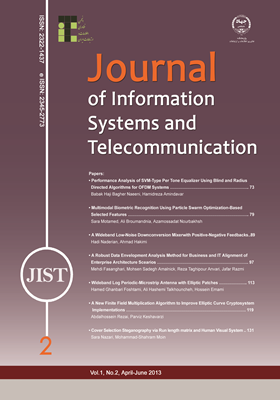A New Finite Field Multiplication Algorithm to Improve Elliptic Curve Cryptosystem Implementations
محورهای موضوعی : Pervasive computingAbdalhossein Rezai 1 , Parviz Keshavarzi 2
1 - Semnan
2 - Semnan
کلید واژه: Computational Complexity, Network Security, Cryptography, Elliptic Curve Cryptosystem (ECC), Finite Field Multiplication, Scalar Multiplication,
چکیده مقاله :
This paper presents a new and efficient implementation approach for the elliptic curve cryptosystem (ECC) based on a novel finite field multiplication in GF(2m) and an efficient scalar multiplication algorithm. This new finite field multiplication algorithm performs zero chain multiplication and required additions in only one clock cycle instead of several clock cycles. Using modified (limited number of shifts) Barrel shifter; the partial result is also shifted in one clock cycle instead of several clock cycles. Both the canonical recoding technique and the sliding window method are applied to the multiplier to reduce the average number of required clock cycles. In the scalar multiplication algorithm of the proposed implementation approach, the point addition and point doubling operations are computed in parallel. The sliding window method and the signed-digit representation are also used to reduce the average number of point operations. Based on our analysis, the computation cost (the average number of required clock cycles) is effectively reduced in both the proposed finite field multiplication algorithm and the proposed implementation approach of ECC in comparison with other ECC finite field multiplication algorithms and implementation approaches.
This paper presents a new and efficient implementation approach for the elliptic curve cryptosystem (ECC) based on a novel finite field multiplication in GF(2m) and an efficient scalar multiplication algorithm. This new finite field multiplication algorithm performs zero chain multiplication and required additions in only one clock cycle instead of several clock cycles. Using modified (limited number of shifts) Barrel shifter; the partial result is also shifted in one clock cycle instead of several clock cycles. Both the canonical recoding technique and the sliding window method are applied to the multiplier to reduce the average number of required clock cycles. In the scalar multiplication algorithm of the proposed implementation approach, the point addition and point doubling operations are computed in parallel. The sliding window method and the signed-digit representation are also used to reduce the average number of point operations. Based on our analysis, the computation cost (the average number of required clock cycles) is effectively reduced in both the proposed finite field multiplication algorithm and the proposed implementation approach of ECC in comparison with other ECC finite field multiplication algorithms and implementation approaches.


